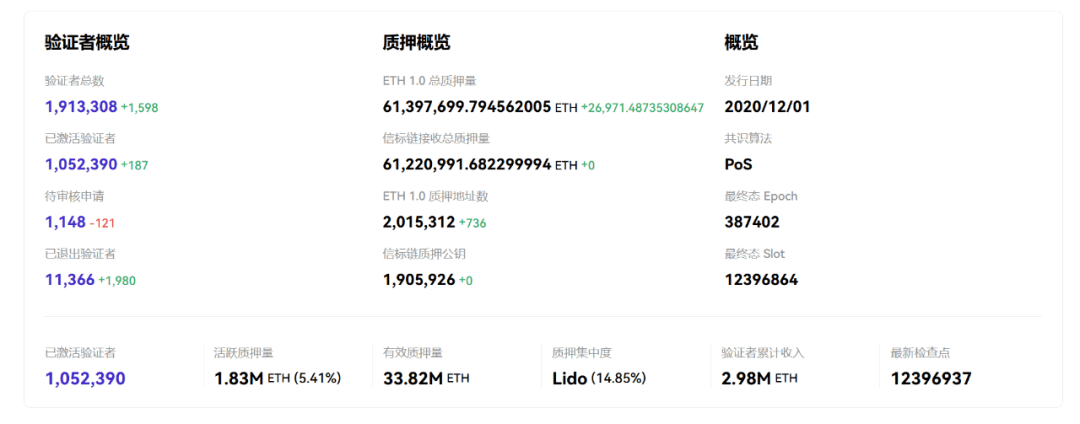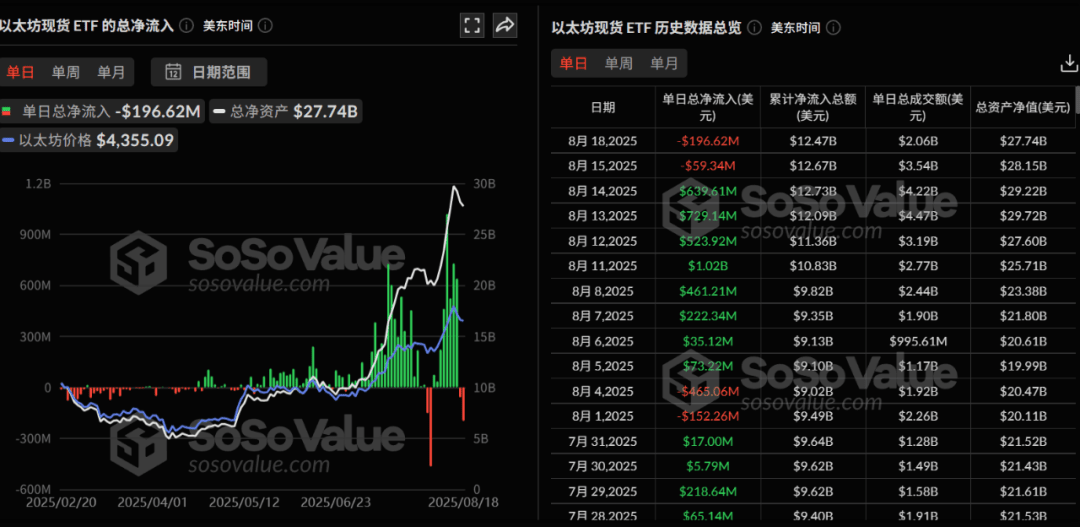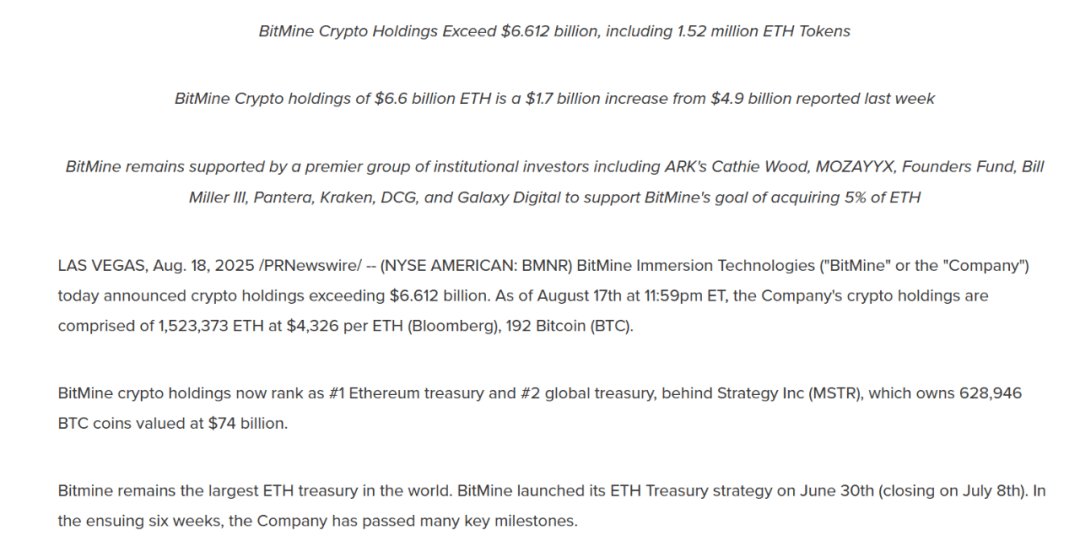Ethereum is standing at an unprecedented 'multi-narrative resonance' node.
On-chain, the scale of ETH staking continues to rise, gradually establishing a 'risk-free interest rate anchor point'; in traditional finance, spot ETFs have been running for over a year, with trading volume and net inflows rapidly increasing, marking a continuous increase in compliant funds; at the corporate level, more and more U.S. listed companies are strategically choosing to include ETH in their treasury reserves.
Staking, ETFs, and corporate treasuries—these three seemingly independent threads are resonating with each other, driving ETH from a single cryptocurrency toward a comprehensive financial asset with yield attributes, compliant channels, and corporate reserve value.
If Bitcoin's story is 'digital gold', then Ethereum's narrative is quietly shifting to 'global ledger', and will usher in a critical 'resonance moment' in 2025.
01. Staking steadily rises, the 'benchmark interest rate' of ETH emerges
Since the Shanghai upgrade opened the staking withdrawal feature in April 2023, Ethereum has completely resolved the dam-like exit risk, releasing the growth potential of the staking ecosystem. Since then, the derivatives market based on LSD has rapidly expanded, pushing the ETH staking rate continuously higher.
As of the time of writing, the amount of ETH staked has surpassed 33.8 million, amounting to approximately $140 billion at the current price, accounting for over 25% of the total supply, a significant increase compared to about 10% staking rate a few years ago. This not only strengthens network security but also enhances the scarcity of ETH from a supply and demand perspective.

More importantly, ETH staking is gradually becoming the 'interest rate anchor point' in on-chain finance.
Over the past year, the annualized staking return rate of 3%-5% has been widely accepted by the market, and some institutional research reports even view it as the 'on-chain version of Treasury yields', forming an implicit comparative relationship with U.S. Treasury yield curves. This characteristic has made ETH not just a trading asset but has endowed it with the underlying logic of a quasi-fixed income product.
Of course, a noteworthy reverse trend has also emerged recently - since July 16, ETH unstaking requests surged, with validator exit requests soaring from less than 2,000 to 475,000 by July 22, and the waiting time extended from less than one hour to over 8 days.
According to The Block data, there are currently approximately 670,000 ETH (about $3.1 billion) in the exit queue, far exceeding new staking demand, with an expected processing time of nearly 12 days. The driving factors for a large amount of ETH unstaking include the unwinding of leveraged staking cycles under the backdrop of rising prices, the decoupling risks of LST, and arbitrage opportunities, making Lido, EthFi, and Coinbase the main sources of exits.

Source: The Block
However, despite the short-term fluctuations brought by the wave of unstaking, from a long-term perspective, ETH staking has gradually become the 'risk-free interest rate anchor point' on-chain, becoming one of the underlying financial logics of ETH.
It is worth noting that in 2024, U.S. Treasury yields have long remained in the 4%-5% range, which made ETH staking rates seem unattractive for a time. However, as the Federal Reserve begins to lower interest rates in 2025, the 3%-5% staking yield of ETH regains competitiveness and is even considered 'excess returns' in some risk models.
This means that a deeper implicit connection is being established between the on-chain interest rates of ETH and the global liquidity environment, especially as re-staking protocols like EigenLayer have absorbed over one hundred billion dollars of ETH participation, giving rise to the chain logic of 'staking rate → re-staking premium → protocol security'.
In other words, ETH is not only an asset in itself but is gradually becoming the underlying collateral of the Web3 financial system.
02. ETFs become the main channel for traditional funds
In May 2024, the U.S. SEC approved the 19b-4 applications of 8 Ethereum spot ETFs, which officially began trading on July 23, marking the formal opening of the compliance channel for ETH and Wall Street. To date, Ethereum spot ETFs have been operating for over a year.
Objectively speaking, as a 'compliance gateway', ETFs provide traditional institutions with a direct channel to allocate ETH, while also reducing compliance friction at the financial and audit levels. According to SoSoValue data, as of now, the total net asset value of U.S. Ethereum spot ETFs has exceeded $27 billion, accounting for about 5.34% of Ethereum's market capitalization, with a cumulative net inflow of $12.4 billion since their launch.
However, the market often overestimates the short-term effects of new things while underestimating their long-term impact. The development of Ethereum spot ETFs is a reflection of this pattern, as the true explosion of ETFs was not immediately evident — before May of this year, the daily trading volume of ETH ETFs remained relatively low, with limited market interest.

Source: SoSoValue
The turning point occurred on August 11, 2025, when the net inflow of Ethereum ETFs exceeded $1 billion for the first time in a single day, with BlackRock's ETHA attracting $640 million and Fidelity's FETH attracting $277 million. The siphoning effect of funds from the two giants is evident, and the institutional shift of Ethereum ETFs has already become apparent.
The significance of ETFs lies in that they are not only a 'channel' for funds but also a 'legal status' in compliance audits and financial statements, greatly reducing the resistance for institutions to hold ETH. Another profound significance is that it opens up arbitrage and allocation paths for cross-border financial institutions.
More importantly, the concentration of ETF holdings has begun to emerge, with BlackRock and Fidelity's two ETFs accounting for 2/3 of the U.S. ETH ETF market. This trend of concentration not only brings about a siphoning effect of funds but may also mean that the 'institutional pricing' characteristics of ETH will become increasingly evident in the future.
03. ETH accelerates influx into U.S. stock balance sheets
If MicroStrategy represents a milestone case for BTC as a public company incorporating crypto assets into its balance sheet, then starting in 2025, ETH is also approaching a similar turning point.
Recently, more and more U.S. stock companies are choosing to include ETH in their treasury, and it is not merely symbolic holding but rather large-scale, strategic allocation.
Taking BitMine as an example, according to official disclosures, its crypto asset holdings have exceeded $6.612 billion, increasing about $1.7 billion from $4.9 billion the previous week, with BitMine holding 1.523 million ETH (calculated at the current price of $4,326 each) and also holding 192 BTC.

Source: BitMine
At the same time, Nasdaq-listed company Cosmos Health also announced a maximum $300 million securities purchase agreement with a U.S. institutional investor to initiate its ETH treasury strategy, providing custody and staking infrastructure through BitGo Trust.
This trend of actively incorporating treasury is different from the passive allocation of ETFs: ETFs carry more of the exposure demand of financial products, while companies directly purchase ETH and incorporate it into their treasury, which means that ETH is becoming an actual settlement medium and reserve asset. Whether for financial diversification, cross-border payments, or employee incentives and research and development incentives, ETH is beginning to show the application potential of 'liquid assets'.
Overall, after experiencing a previous wave of widespread skepticism, Ethereum's multiple narratives are beginning to consolidate:
Staking yields have brought ETH a quasi-'Treasury' interest rate anchor;
ETFs have opened the allocation channel for compliant funds;
The corporate treasury further endows ETH reserves and payments with real value;
The three intertwine to jointly push ETH from 'cryptocurrency' to 'financial infrastructure asset'.
If Bitcoin represents 'digital gold' in corporate treasuries, then Ethereum's value narrative is gradually pointing to the 'liquidity core of the global ledger'.


